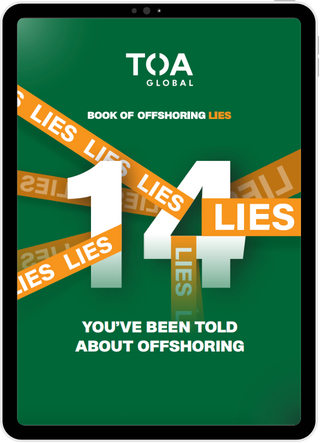Introduction
As an accounting firm owner or manager, you’re constantly looking for ways to boost efficiency, reduce errors, and scale your operations. The best way to do this? Document your process.
In this article, we will guide you through process documentation, discuss why it’s important for your firm’s success, and show you a practical, phase-by-phase approach. By the end, you’ll have a clear roadmap for your firm’s operations, allowing you to gain insights for consistency and even possibly, offshore growth.
What is Process Documentation
Process documentation is used to clearly outline the steps involved in completing a task or workflow in your firm. Think of it as creating a detailed “how-to” guide for every recurring activity, so your team has standardized procedures that everyone can follow.
Process documentation examples in an accounting firm could include:
- A step-by-step guide for the client onboarding, from initial contact to software setup.
- A checklist for monthly bank reconciliations, ensuring no step is missed.
- A narrative guide for preparing a specific type of tax return, detailing data collection and submission.
- A video tutorial demonstrating how to use a new accounting software feature.
These process document examples provide clarity and consistency, which are vital for the operations of any growing firm.
Understanding the ‘what’ in documenting processes is just the beginning. To truly make a process document useful for employee productivity, you must also understand the core purpose behind it and the significant advantages process documents offer.
What is the Purpose of Process Documentation
Process documentation aims to create a standardized, repeatable framework for your firm’s operations or complex processes. This establishes the process scope, corrects inaccurate documentation, and provides clear, consistent processes for every task to maintain predictable and reliable process flow.
Process documentation also eliminates variations and mitigates errors and inefficiencies. This way, clients consistently receive high-standard services, whether for tax preparation or monthly bookkeeping.
Detailed process documentation provides a reliable reference for training new employees, so they can quickly grasp process steps and best practices. This makes accounting or business process documentation an invaluable tool for troubleshooting the process flowchart when issues arise and points to where a particular process might have broken down.
Most importantly, process documentation forms the basis for continuous improvement or task automations, so your firm can analyze, refine, and optimize workflows over time. It builds a resilient, efficient operational backbone that supports growth, reduces reliance on individual knowledge, and allows your firm to go through process tasks effectively.
What are the Benefits of Process Documentation
- Enhanced Consistency
- Reduced Errors
- Streamlined Onboarding
- Improved Efficiency and Productivity
- Easier Scalability - Better Knowledge Retention
- Better Compliance and Risk Management
- More Empowered Team
- Established Foundation for Automation
Thorough process documentation is more than just keeping things organized for your accounting firm. It offers significant benefits by using best practices to transform your standard operating procedures. Here are some of the benefits of process documentation:
- Enhanced Consistency and Quality: Effective process documentation creates consistent, high-standard work, reduces variations, and creates a more reliable client service.
- Reduced Errors and Rework: Clear instructions minimise misunderstandings and mistakes, especially for firms that utilize offshore services. A clear process document ensures there are fewer errors and less time spent on corrections when you create documentation guidelines.
- Streamlined Onboarding and Training: New employees get up to speed much faster with comprehensive workflow documentation already lodged in the firm's knowledge base. This accelerates productivity and reduces the burden on existing staff.
- Improved Efficiency and Productivity: Well-defined processes make for quicker and more efficient task completion, so it frees up time for higher-value activities and client relationships.
- Easier Scalability and Growth: As your firm expands, process documentation becomes indispensable for growing your team and client base without sacrificing quality or control.
- Knowledge Retention and Business Continuity: Process documentation preserves organizational knowledge for business operations, so your firm continues to perform tasks efficiently, even if key team members depart. However, it is important to note that this also means you have to update your process documents regularly as best practices evolve over time.
- Better Compliance and Risk Management: Process documentation helps with adherence to regulations. It is helpful for both old and new employees in outlining the necessary steps and checks to mitigate risks to each process in the firm.
- Empowered Team Members: When your team has clear instructions and resources, they feel more confident and empowered to perform duties independently, so you don’t waste valuable talent resources on constant supervision.
- Foundation for Automation: Clear process documentation is the first step toward identifying opportunities for automation to enhance efficiency within the firm.
How to Document a Process for Accounting
Documenting your accounting processes might seem overwhelming, but by breaking it down into manageable phases, you can achieve better results with your process outputs:
Phase 1: Preparation and Planning

The success of your documentation process hinges on solid preparation. It’s time to say goodbye to outdated documentation. Instead, create a solid knowledge base to help your employees execute tasks better with well-documented processes:
Identify and Prioritize Processes
Begin by listing all the key processes within your firm. Then, prioritize them based on impact, frequency, complexity, and urgency.
Which processes cause the most headaches? Which are critical for client satisfaction? Start with those that will yield the most significant immediate benefits.
For example, monthly closing procedures or payroll processing are often excellent starting points because of their recurring nature and importance.
Define the Scope of Each Process
For each prioritized process, clearly outline its beginning and end points.
What triggers the process? What is its ultimate output? Defining the scope ensures that your process document remains focused.
Assemble Your Documentation Team
While one person might oversee the project, involve the team members who perform the tasks. They are the subject matter experts, and their input is invaluable for accurate and practical workflow documentation.
Phase 2: Information Gathering and Mapping

This phase is about understanding the “how” of your operations so you can create a comprehensive and centralized knowledge base.
Gather Comprehensive Information
Collect all relevant details about the process. This includes interviewing team members for best practices, observing tasks as they are performed, reviewing existing notes, and gathering any templates or forms used.
Ask questions like: “What are the common challenges?” or “Are there any workarounds currently in use?”
Map the Process Flow
Visually represent the sequence of your process steps. This could involve creating a simple flowchart, a diagram showing who does what, or even just a bulleted list that eventually makes it to your knowledge base. This helps identify bottlenecks and inefficiencies and to establish best practices later on.
The goal is to use text, audio, or visual tools, or a combination of all, to clearly illustrate the progression of tasks and processes, from start to finish.
Phase 3: Writing and Structuring the Documentation

The next step is to synthesize the collected data, analyze it thoroughly, and document processes to enhance your firm’s operational efficiency.
Select a Documentation Format
There isn’t a one-size-fits-all solution in process documentation. Consider which format best suits the complexity and nature of your firm or client’s business process, as well as your team’s learning styles. Some common process document options include:
- Flowcharts: Diagramming tools, tables, flowcharts, and other visual elements are excellent for pointing out decision points and complex sequences.
- Checklists: Ideal for ensuring all critical steps are completed, especially routine tasks.
- Narrative Guides: Narrate a step-by-step process and detailed instructions to document a process, often with visual representation and screenshots.
- Video Tutorials: Highly effective for demonstrating software usage or complex manual tasks, using visual representation to explain complex steps in different processes.
Write Clear, Concise, and Actionable Steps
Use simple language and avoid unnecessary jargon. Each step should be easy to understand and follow, so it leaves no room for ambiguity. Use active voice and imperative verbs (e.g., “Click here,” “Enter data”).
Identify Essential Components of Your Process Document
An effective process document should typically include the following elements:
- Purpose and Scope: What does the process want to achieve? Outline the purpose of the document and establish process boundaries.
- Roles and Responsibilities: Who are the stakeholders involved in each part of the process? Address the process guide duties, and pinpoint who is responsible for each, especially if it involves multiple people, to establish accountability.
- Triggers and Inputs: What initiates the process? Discuss the information or resources needed to start the business process.
- Outputs and Deliverables: What outputs or deliverables should result from this process? Will external process documentation be necessary? Discuss the expected outcome or results.
- Step-by-step instructions: What are the steps to reach your end goal? Create a guide that discusses the key components required for each action. Include visual aids if you deem them necessary, too.
- Tools and Software Used: What are the applications, platforms, or physical tools necessary to complete tasks? Make a list of all available tools you already have, and others (including documentation tools) that you may need.
- Key Performance Indicators (KPIs): How will the success or efficiency of this process be measured? Establish a standard for how team members perform tasks to guarantee service consistency.
- Troubleshooting and FAQs: What are the common issues and their solutions? Address the most common problems and answer all frequently asked questions related to the process.
- Definitions of terms: Are some terms too technical? Create a glossary for any specific terminology used.
Phase 4 Review, Test, and Implement
The final phase makes sure your process documentation is accurate and effective so that it can be adopted by your team.
Review and Validate with Stakeholders
Once drafted, have the team members use the document and review it thoroughly. This makes the process documentation tool to identify accuracy, completeness, and usability. The team’s feedback is especially important for refining the document for process improvement, making it both effective and efficient.
Implement and Train Your Team
When all the details have been tested and reviewed for optimal usability, input the document into your firm’s centralized knowledge base, roll out the document, and provide training on its use and importance. Explain why process documentation is valuable and how it will benefit everyone.
What are the Essential Accounting Processes to Document

Each firm has unique needs, but certain core accounting and business documenting processes are universally beneficial. Focusing on effective process documentation provides a solid foundation for your own firm’s operational efficiency.
- Client Onboarding and Setup: This sets the tone for the client relationship. Documenting this process creates a consistent experience, from the initial contact and engagement letter to software setup, initial client communication, and data gathering.
- Monthly/Quarterly Close Procedures: These recurring tasks are the backbone of financial reporting. Detail every step for bank reconciliations, journal entries, financial statement preparation, and internal review. A well-documented close process significantly reduces stress and improves accuracy.
- Payroll Processing: Given strict compliance and deadlines, a clear invoice automation process manual for payroll makes it easier to ensure compliance checks, tax preparation and filings, and direct deposit procedures.
- Accounts Payable and Receivable Management: From invoice receipt and creation to payment processing and collection, these processes directly impact cash flow.
- Internal Administrative Processes: Don't overlook internal procedures like software updates, internal reporting, team meeting agendas, and general office management. Process documentation serves as a blueprint to maintain operational fluidity.
Conclusion
Process documentation is a strategic move for your accounting firm. By investing the time in documenting processes and refining your workflows, you can determine process inputs that help improve operational efficiency.
Process documentation best practices empower your team, safeguard your knowledge, and position your firm for long-term success and adaptability in an ever-evolving environment. Start your documentation journey today, and watch your firm transform.
















